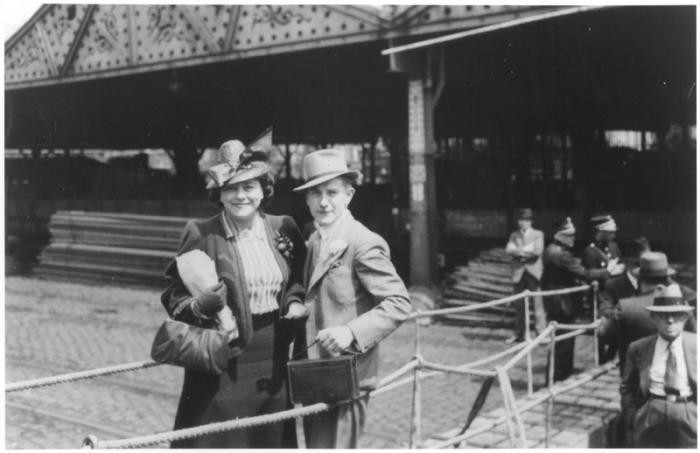
Return to Europe of the St. Louis
After the denial of safe haven in Cuba and neglected appeals for entrance into the United States, the passengers of the St. Louis disembarked in Great Britain, France, Belgium, or the Netherlands. The fate of the passengers in each depended on many factors subsequently, including geography and the course of the war against Germany.
Key Facts
-
1
In each country, refugees faced uncertainty and financial hardship. Initially, they were given temporary status and often were housed initially in refugee camps.
-
2
Passengers underwent experiences similar to those of other Jews in Nazi-occupied western Europe. The Germans murdered many of them in the killing centers and the concentration camps. Others went into hiding or survived years of forced labor. Some managed to escape
-
3
Of the 620 passengers who returned to the continent, 532 were trapped when Germany conquered Western Europe. Just over half, 278 survived the Holocaust. There were 254 passengers who died: 84 who had been in Belgium; 84 who had found refuge in Holland, and 86 who had been admitted to France.
On June 6, 1939, the St. Louis turned back toward Europe. Seven days later, while the ship was crossing the Atlantic, an agreement was reached that gave the passengers new hope. Working with other European Jewish organizations and government representatives, Morris Troper, the European director for the Joint Distribution Committee (JDC), had arranged for the St. Louis passengers to enter Great Britain, France, Belgium, and the Netherlands. Great Britain took in 287 passengers, France 224, Belgium, 214, and the Netherlands 181.
The St. Louis docked at Antwerp, Belgium, on June 17, after more than a month at sea. Less than three months later, World War II broke out. Within the year, all of western Europe would be under German occupation, and the former St. Louis passengers who were on the Continent would again be threatened by Nazi terror.
Before disembarking, the passengers completed questionnaires that government representatives and relief agencies may have used to decide their destinations. They were asked for the names of friends and relatives in Great Britain, France, Belgium, and the Netherlands, as well as details about their applications for American visas and the quota waiting list numbers showing that they intended to immigrate to the United States. The refugees were granted only temporary asylum; they had to agree to eventually emigrate to more permanent homes elsewhere. The assumption was that they would leave as soon as their US quota waiting list numbers were called or as soon as they had another place to go. Government officials, already worried about the rising tide of Jewish refugees from the Reich, made it clear that the treatment of the St. Louis passengers was an exceptional case and not a precedent for others who were fleeing Germany.
Passengers bound for Belgium disembarked first, and took a special train to Brussels, where they stayed overnight. Those who had no relatives in the city were taken to a refugee center in the province of Liege.
The passengers chosen for the Netherlands sailed the next day aboard the ship "Jan van Arkel." Upon their arrival in Rotterdam, Dutch authorities took them to a temporary refugee center where they remained until they found housing or were moved to other refugee camps.
Passengers assigned to France and Great Britain boarded a freighter that had been refitted to hold them. The ship arrived on June 20 in Boulogne sur Mer, where those with destinations in France disembarked. The next day, they went to Le Mans, Laval, and other French towns. The JDC arranged for about 60 children to be cared for by the Jewish Children's Aid Society (Oeuvre de Secours aux Enfants; OSE). They were placed in several homes in Montmorency, just north of Paris.
On June 21, those assigned to Great Britain arrived in Southampton and were taken by special train to London. There, the German-Jewish Aid Committee arranged housing for those who were not staying with family or friends. Most people moved into private homes or hotels, but about 50 single men were taken to a former British army camp, in Kent, that the British government had allocated for the use of refugees.
The former passengers faced uncertainty and financial hardship. Upon leaving Germany, they had been systematically dispossessed of their property by the Nazis. They were prohibited from working. Consequently, the former passengers were totally dependent on relatives and Jewish relief agencies. To prevent them from becoming public charges, the JDC agreed to allocate $500,000—a sizable portion of its funds—to provide for the refugees.
Most of the former passengers hoped to find permanent homes, primarily in the United States. The 600 or more on waiting lists for US visas patiently waited for their numbers to be called. Others tried to get entry permits at foreign consulates, but few countries were willing to accept impoverished immigrants. Making matters worse was the British Government's White Paper of 1939, which restricted immigration into Palestine.

